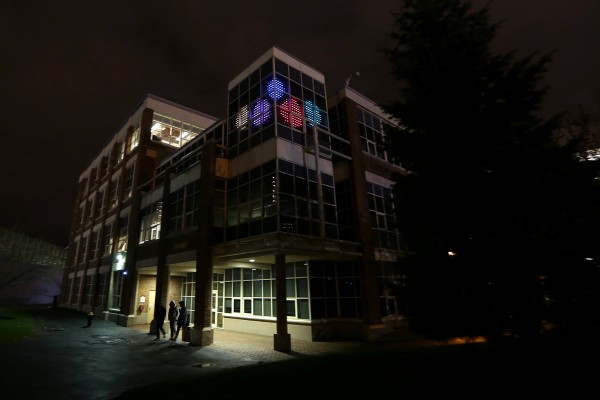Your mood in lights

How do you feel about finals? Anxious? Exhausted? Relieved?
Share your feelings with the Northeastern community by voting online or by pressing one of the color-coded buttons outside of Ryder Hall. Select red for anxious, purple for exhausted, or blue for relieved.
The results will be displayed each night after sunset in a three-dimensional LED matrix, which is mounted on the building’s façade and comprises 900 lights.
Dubbed “.vote,” the display is the result of a collaboration between Philips Color Kinetics and Northeastern’s Master of Fine Arts in Information Design and Visualization, a new two-year interdisciplinary program in the College of Arts, Media, and Design in which students learn to translate and communicate information into visual, physical, and virtual forms.
On Thursday evening, a score of students, faculty, and staff gathered at Centennial Common for the official opening of the interactive installation, which will remain on display until the fall. After finals, a new question will be posed to the Northeastern community.
.vote was created by six graduate students in the MFA program for a course titled “Information design for dynamic media and light.” Dietmar Offenhuber, an assistant professor of information visualization, and Susanne Seitinger, the city innovations manager for Philips Color Kinetics, co-taught the course, which aimed to demonstrate the power of outdoor lighting systems in urban settings.

The .vote project is a new installation in Ryder Hall, completed by students in Northeastern’s Information Design and Visualization MFA program in collaboration with Philips Color Kinetics. Photo by Maria Amasanti.
You can let the group know what you think of the installation and share ideas for future polls by emailing your suggestions to idv-students@neu.edu. Don’t be afraid to get creative. “We want to use this technology to develop infrastructure that can be used by students of any discipline,” said Offenhuber, who holds joint appointments in CAMD and the College of Social Sciences and Humanities. “There is already a lot of interest from other departments throughout the university to develop experiments that can be run on the façade.”
.vote’s diverse array of potential applications aligns with the academic makeup of the first cohort of students in the information design and visualization program: Their undergraduate backgrounds range from biology and philosophy to economics and motion design.
Ashley Treni, MA’15, studied graphic design and was introduced to the master’s program by Nathan Felde, the chair of the Department of Art + Design. “I’ve always been interested in visualizing systems and interaction design,” Treni said. “The exciting thing about this program is that we’re able to explore all of these emerging fields, including data mining, information design, experience design, and systems design.”
Her contribution to the interactive installation included designing text for the LED matrix. But collaboration was key, she said, especially when programming was involved.
“We all worked together and gave each other feedback,” Treni explained. “Our goal was to create a space for students, faculty, and staff to interact with something and then be able to see the collective sentiment of the Northeastern community.”





